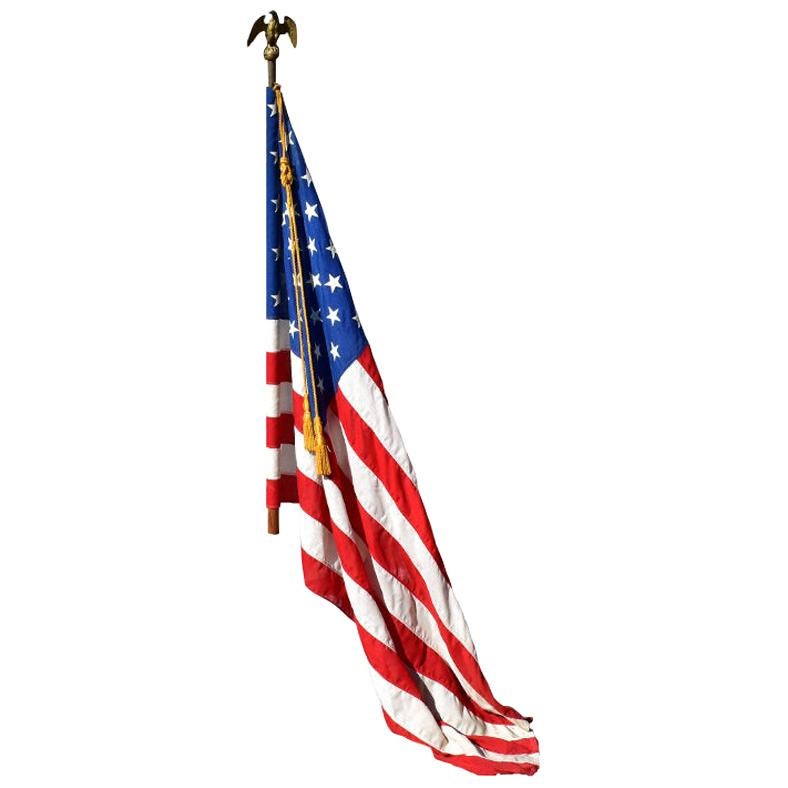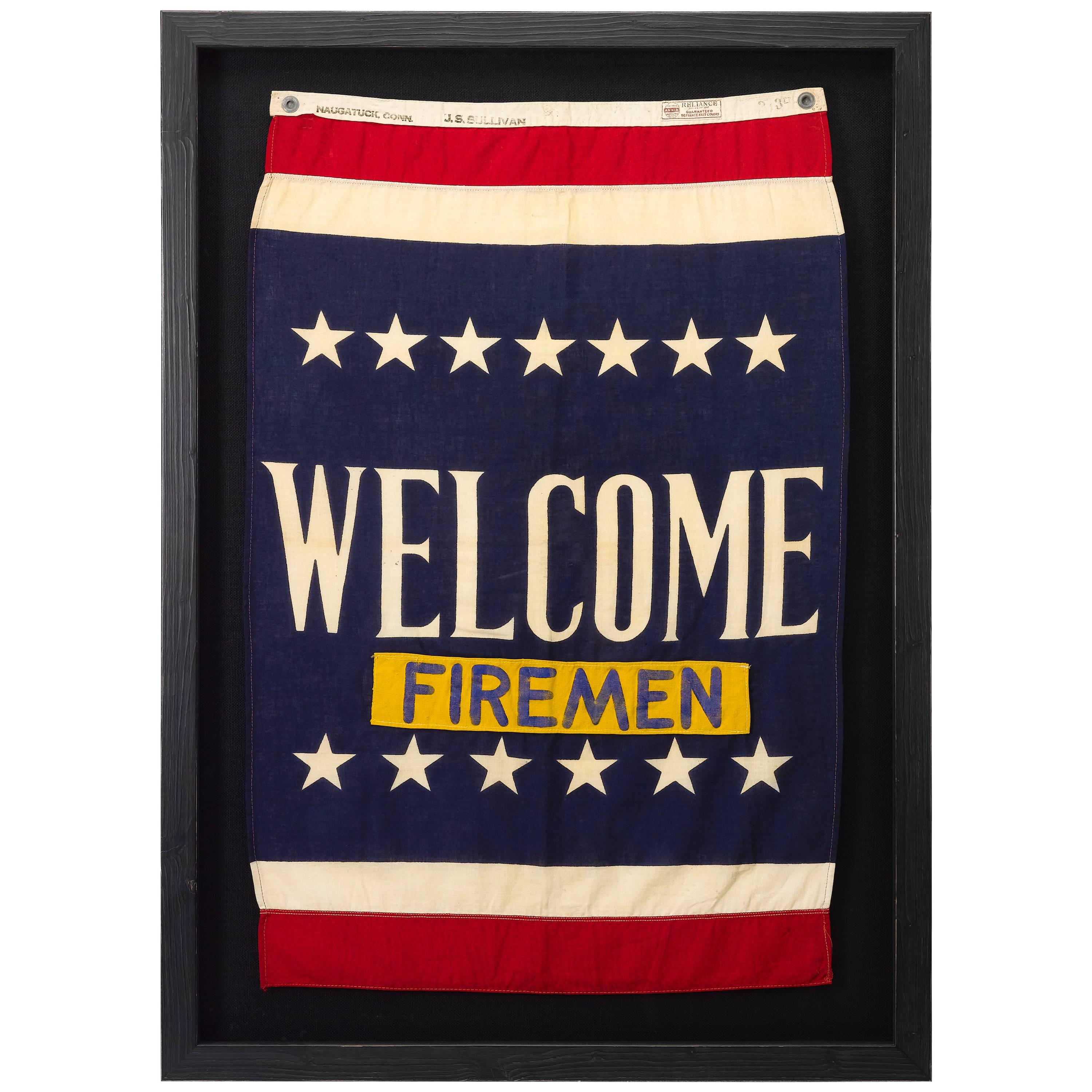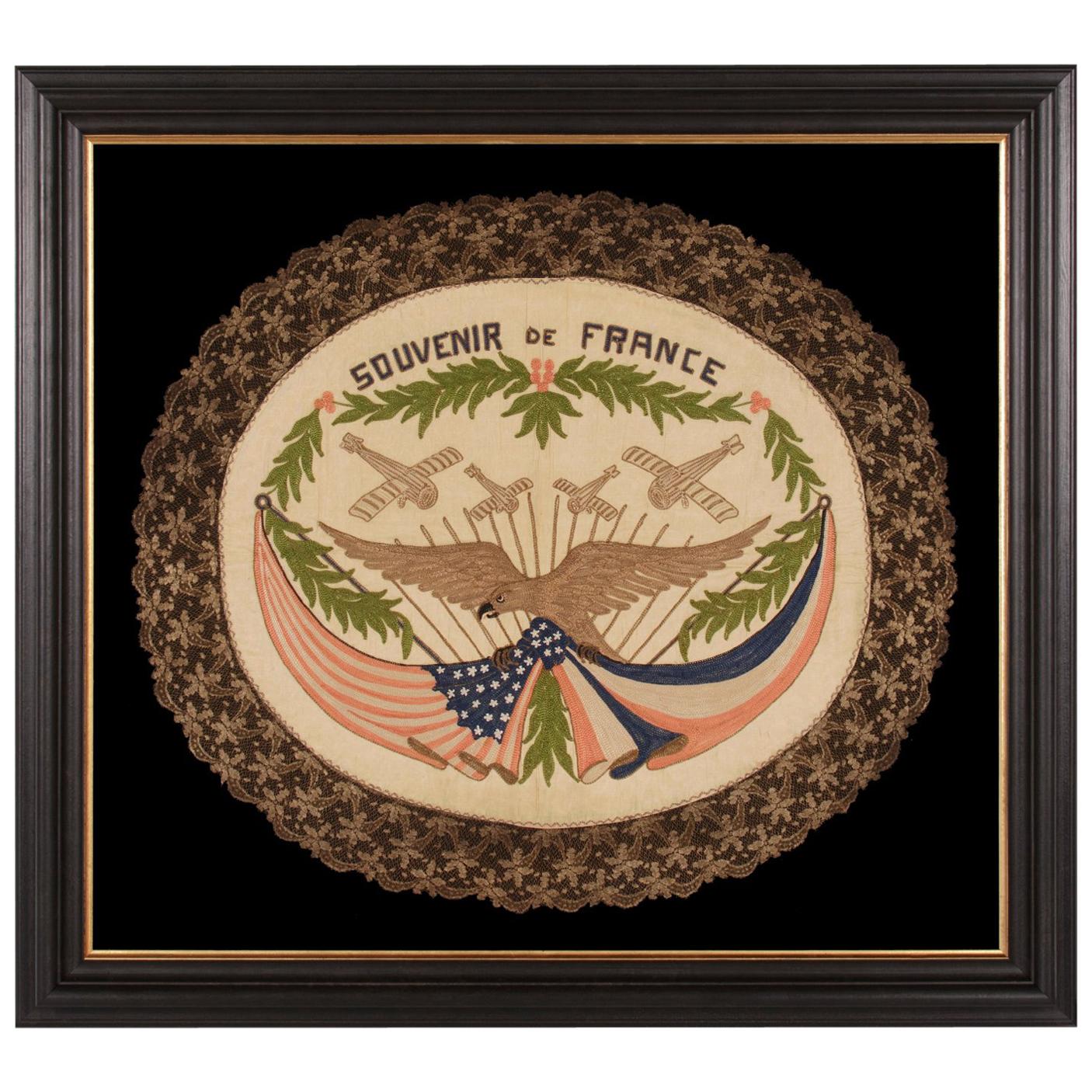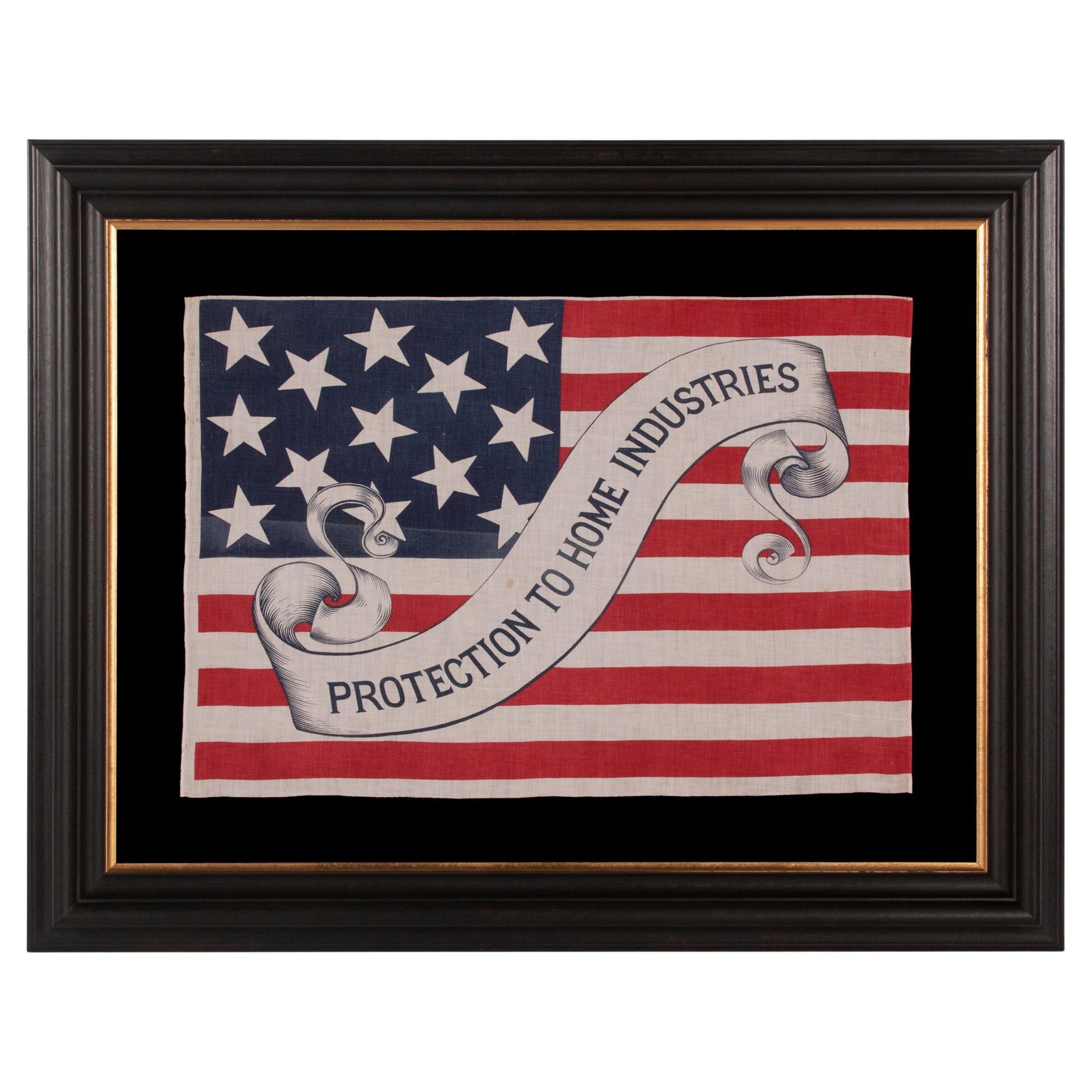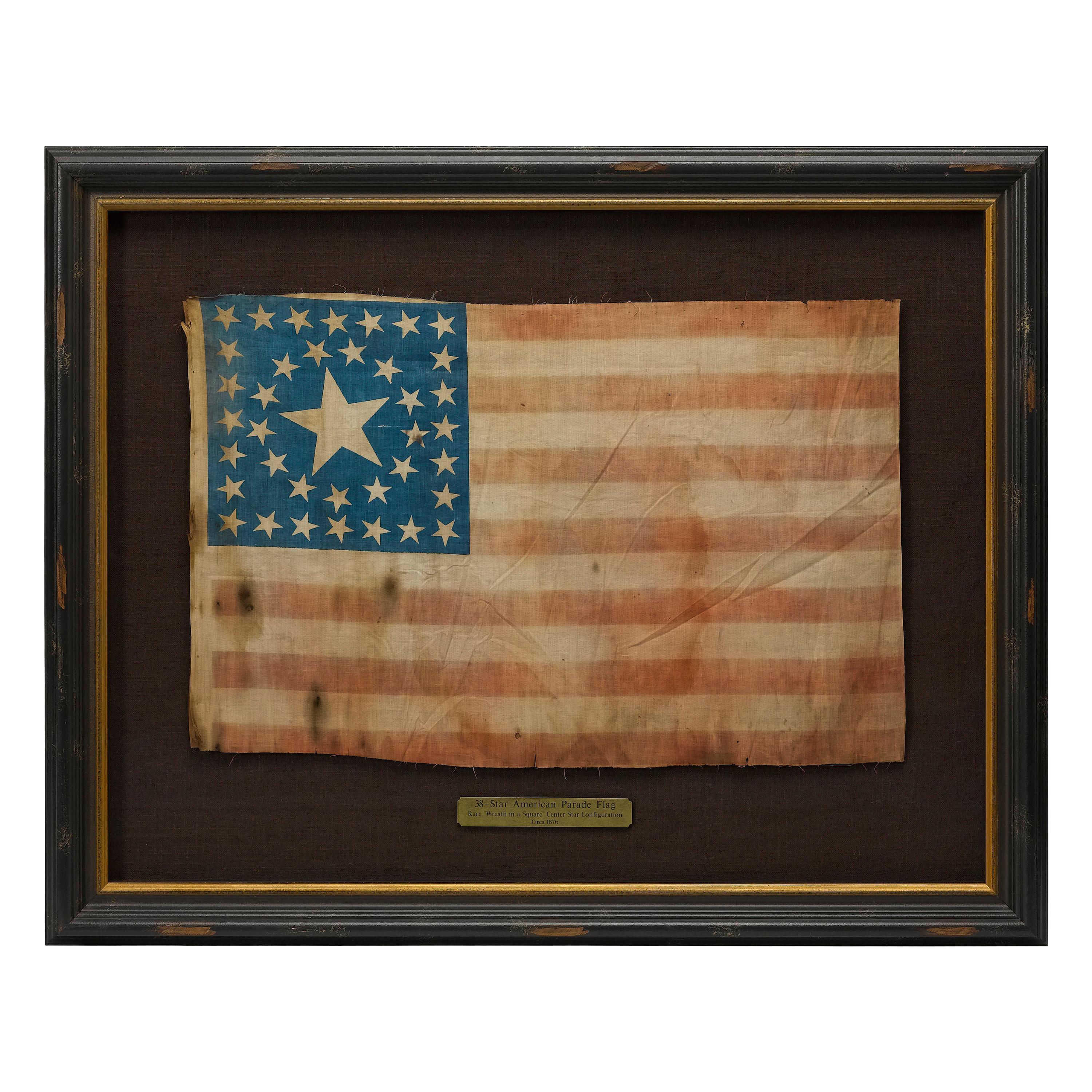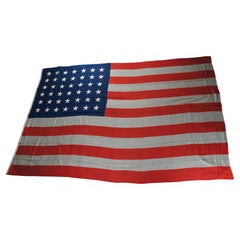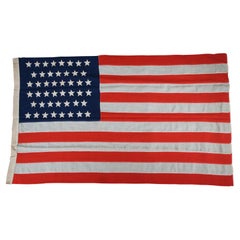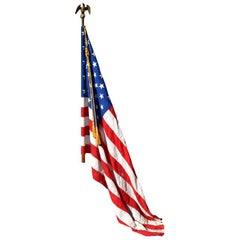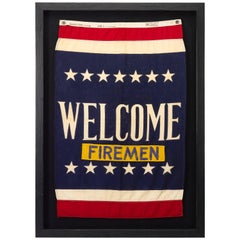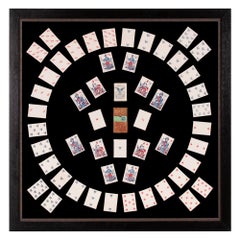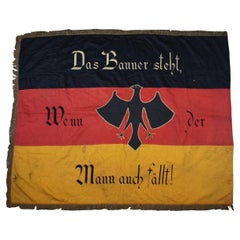
1925 Rare Antique German Reichsbanner Imperial Eagle Banner Flag 57"
View Similar Items
Want more images or videos?
Request additional images or videos from the seller
1 of 13
1925 Rare Antique German Reichsbanner Imperial Eagle Banner Flag 57"
About the Item
- Dimensions:Height: 45 in (114.3 cm)Width: 57 in (144.78 cm)Depth: 0.125 in (3.18 mm)
- Materials and Techniques:
- Period:
- Date of Manufacture:1925
- Condition:Wear consistent with age and use. Good Overall - Some fading/stains from age; couple of holes.
- Seller Location:Dayton, OH
- Reference Number:Seller: 341731stDibs: LU5343229638082
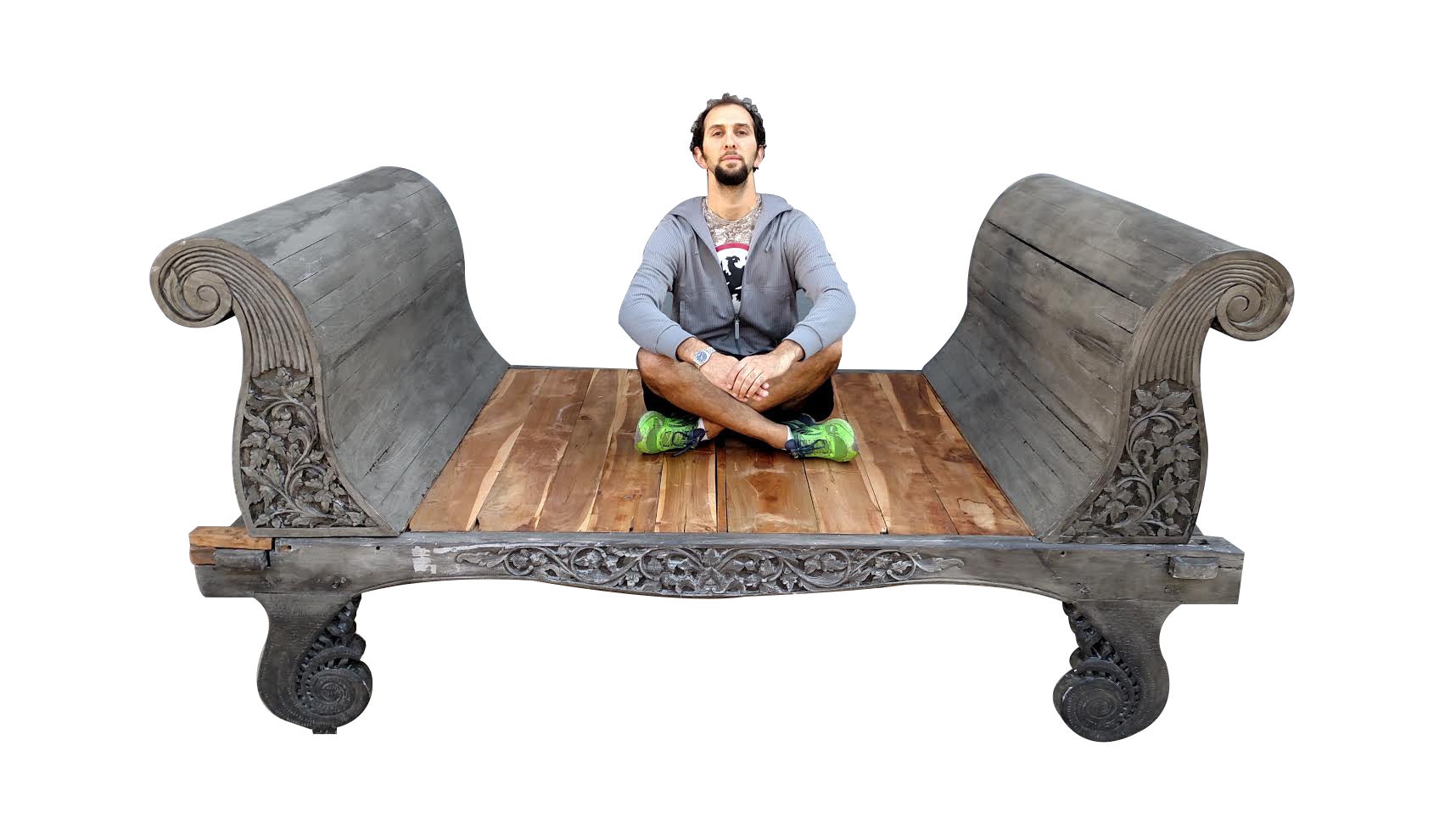
About the Seller
4.9
Platinum Seller
These expertly vetted sellers are 1stDibs' most experienced sellers and are rated highest by our customers.
Established in 2010
1stDibs seller since 2020
1,114 sales on 1stDibs
More From This SellerView All
- Rare Monumental 1890 Antique 42 Star United States of America FlagLocated in Dayton, OHMonumental fifteen foot 42 star American flag, circa 1889-1890. The 42-star flag is rare because only a limited number of 42-star flags were produced after Washington became a state on Nov. 11, 1889. But it takes a more intimate knowledge of flag trivia to know just why it happened this way. White stars are added to the blue field of the star-spangled banner on the Fourth of July after a state is admitted to the union. In the fall of 1889, several western territories became states. Dakota was admitted, and then split into North and South Dakota, on Nov. 2, 1889, which made them state and star numbers 39 and 40. Montana was named the 41st state on Nov. 8, followed by Washington, on Nov. 11. Only a few flag manufacturers began producing 42-star flags before the official addition of the 42nd star on July 4, 1890. Those who tried to jump the gun by being the first to produce an up-to-date flag were surprised when Idaho was admitted to the United States on July 3...Category
Antique 1890s American Classical Historical Memorabilia
MaterialsCotton
- Antique 46 Star WMH Horstmann Company United States of America Flag 83"By HorstmannLocated in Dayton, OHAntique forty six star large wool American flag by Horstmann Company, circa 1908-1912. Horstmann firm was founded by William H. Horstmann (1785-1850), who had immigrated to Philadelphia from Germany. Horstmann bought out a local swordmaker in 1828 and thereafter entered the military goods field. The firm benefitted from the Civil War, becoming the largest military goods supplier in the nation by 1864. WILLIAM H. HORSTMANN & SONS, Manufacturers of Dress Trimmings and Military Goods. 5th & Cherry Streets, Philadelphia, PA. This house was founded, in 1815, by William H. Horstmann, a native of Cassel, in Germany. He had learned the trade of silk-weaving in France, and, emigrating to the United States in the above-mentioned year, established himself in Philadelphia as a manufacturer of fringe, laces and trimmings of various kinds. He married the daughter of Frederick Hoeckly, a German settler in Philadelphia, and also a manufacturer of fringe, coach-lace and tassels. He devised several improvements in this trade, especially by introducing varieties in the styles and patterns of this class of goods, there being at that time only two patterns used in the trade, which were known as the Jefferson pattern and the Monroe pattern. In 1824, he introduced into this country from Germany the use of plaiting or braiding machines, and about the same time he was the first to introduce into this country the use of the Jacquard loom, for weaving patterns in textile fabrics. His location was in the first instance at No. 50 North Third street, but within a short time he removed to a store next to the Harp and Crown tavern, afterwards known as the City hotel, and continued his business within a short distance of this point for many years. In 1828, he commenced the manufacture of military trimmings as a special department, and this branch has grown to most important proportions, Horstmann's military goods being in demand throughout time country. The firm have also executed large Government contracts in this line for the War and Navy Departments. In 1831, he established a branch house in New York city, and about the same time erected a factory at the corner of Germantown road and Columbia avenue. The factory was continued here until time erection of the extensive building at Fifth and Cherry streets, where the works, salesrooms and offices of time firm now are. This massive structure is six stories high, and extends 140 feet on Fifth street and 200 on Cherry street, and reaches back to Race street. The separate departments into which the business is divided are thirty in number. More than 1000 distinct looms and machines are in use in the building, many of them very costly and some invented and used exclusively by this firm, the motive power being supplied by a steam engine of fifty horse power. The area covered by the works is about 11,000 square feet. Time number of hands employed is very large, about 500. When the erection of a vast factory at this point was first proposed, a strong opposition was made by time holders of the neighboring property. The ancient German Lutheran Church and burying ground, since removed, stood opposite the site, and a bill was introduced into the Legislature to forbid the use of a steam engine within 100 yards of any place of worship. The interests which such a bill would have affected injuriously, especially those of several newspapers, roused a strong opposition to it, and it failed to become a law. In 1845, William H. Horstmann, the founder of the house, retired from the business, and his two sons, William and Sigmund, assumed the management and it was under their direction that the new building, above described, was erected. The goods produced by this house are of almost endless extent and variety. They include goods woven from all the various textile fibres—cotton, wool, silk, etc.—in every style, color and pattern, and are used for an infinite number of purposes. Narrow woven goods are time staple production, made up into material for dresses for both sexes, for use in daily life, and for regalia for ""societies;"" for the costumes of the stage, the upholstering of houses and of carriages, the uniforms of soldiers, together with equipments for the same, and for funeral purposes. The raw material used in the manufacture is to a great extent very costly, and their store rooms often hold as much as $200,000 worth of goods in an unworked state. There are two rooms devoted to power looms in the factory, one for coach lace and one for other styles of weaving, in which about 250 of these machines are constantly running. The braiding machines in the coach lace room are very noteworthy. The cord to be covered with braid is drawn through an opening in time middle of a flat, circular, metallic plate, about 15 inches across. Up to a point on this cord, about a foot above the plate, the threads of the braiding material converge, like the ribs of a tent-roof, and there weave in and out and out and in, as the coating of braid grows, and time covered cord rises and is wound away above. The weaving is accomplished by the motion of the spools below that carry the different threads of the braid. These spools stand in uprights, which are carried round and amongst each other in curved slots in the above-mentioned broad metallic plate. All but two of these spools run in and out among each other, with a swift, easy and intricate motion, mind so rapid that time eye can hardly follow it, while one or two special spools run steadily round and round among time twisting spools with the most extreme swiftness. Many other machines, displaying equally ingenious mechanism, are used in the factory. The various details of equipment manufactured and supplied by this house are also important, both for their number and the superior quality of the manufacture. The one article of swords may be taken as an instance. This trade grew naturally and immediately out of the established army and navy goods department of the works, it being necessary that the sword itself should be furnished together with the sword-belt and other trappings all complete. Every part of the sword and trappings, with the exception of the blade, is made on the premises. The blades are almost all imported from the ancient German sword-blade emporium of Solingen, where, it is said, swords have been made ever since the year 1147, when Count Adolphus of Berg brought home from the East and established there the business of forging Damascus blades. There is in this department a stock of some thousands of blades, of many different patterns and sizes, ready to be set and finished. Any style or sword can be had from this warehouse, from the plainest kind up to a presentation sword...Category
Vintage 1910s American Classical Political and Patriotic Memorabilia
MaterialsWool
- Antique German Catholic Journeymen Association Dayton Ohio Embroidered Flag 71"Located in Dayton, OHAn antique early 20th century German Catholic Flag. Front reads: Katholischer Gesellen Verein (Catholic Journeymen Association) / Gegrundet 1868 (Fou...Category
Early 20th Century Late Victorian Historical Memorabilia
MaterialsMetal
- Rare Antique 19th Century Lot of 41 German Labor Trade Union Ribbons Medals PinsLocated in Dayton, OHLarge rare lot of 41 assorted late 19th – early 20th century antique labor union ribbons / pins, primarily from the German speaking Community of Dayton, Ohio, plus a smattering of other cities including Cincinnati, Piqua, and Canton Ohio...Category
Antique 19th Century Victorian Collectible Jewelry
MaterialsEnamel, Metal
- Antique German Bisque Black Ebony Girl Doll Cloth Body Leather FeetLocated in Dayton, OHAntique 19th century doll with black bisque head and hands, glass eyes, sawdust filled cloth body, and sewn leather shoes/feet, dressed in white bloomers ...Category
Antique 19th Century Victorian Toys
MaterialsCeramic, Leather, Fabric
- Antique German Paper Mache Bobble Head Mule Donkey Pull Cart ToyLocated in Dayton, OHRare antique German paper mache composition bobble head mule / donkey / horse pull toy figure standing with a small feed manger on a platform rollin...Category
Early 20th Century Folk Art Toys
MaterialsHardwood, Paper
You May Also Like
- Antique Federal Eagle American 50 Star Flag with Brass Eagle Pole, 19th CenturyLocated in Oklahoma City, OKMonumental 50 star American Flag with antique Federal Eagle brass and wood pole. A patriotic piece suitable for any home. This set includes both ...Category
Antique 19th Century American Federal Political and Patriotic Memorabilia
MaterialsBrass, Bronze
$4,800 Sale Price20% Off - Vintage WWII U.S. Navy Patriotic Banner, "Welcome Firemen" Flag, circa 1941-1945Located in Colorado Springs, COThis is a beautifully preserved WWII Navy aircraft carrier banner, emblazoned with a welcome for the ship's firemen. The banner is partially printed and has sewn elements. The flag's field is dyed a rich navy blue, with a resist dyed white stripe and a sewn red stripe at both top and bottom. A large "WELCOME" is resist dyed at center, in big white letters. This is followed by a sewn yellow strip of contrasting fabric, printed with the word "FIREMEN" in blue. Thirteen white stars complete the design of this patriotic piece of WWII and Navy history. The banner retains its original white hoist, with two metal grommets on each side, for ease in display on the ship. Along the center of the hoist is the printed name of "J.S. Sullivan." "Naugatuck, Conn." is printed along the left and the size "2 x3 FT" is printed along the right. The flag maker, Annin, has sewn in its label, boasting "guaranteed defiance fast colors." CONDITION: Very good condition, considering age and past use. Partially printed and hand-sewn flag construction. Some toning to the white of the flag and along the top hoist. Original grommets at left and right of the hoist. The flag measures 36" X 22". Expertly framed on black linen with an antiqued black wood...Category
Vintage 1940s American Political and Patriotic Memorabilia
MaterialsLinen
$2,500 Sale Price36% Off - 1862 Civil War Playing Cards with Stars, Flag, Sheilds and EaglesLocated in York County, PA1862 Civil War playing cards with stars, flags, shields, & eagles, and face cards illustrating civil war officers and lady, Columbia, ca 1862, Benjamin Hitchcock, New York 1862 Civil War playing cards with suits represented by stars, flags, shields, & eagles, in lieu of the traditional French suits of hearts, diamonds, clubs, and spades. The face cards feature Union Army officers and Lady Columbia [a.k.a. Lady Liberty, Goddess of Liberty]. Entitled “Union Playing Cards,” two versions of this deck were produced in New York by Benjamin W. Hitchcock’s “American Card Company.” This is the earlier of the two. The other was released in 1863. There are 52 cards in total with the ace of spades doubling as the title card, as was often the case during the 19th century. The telescoping box...Category
Antique 1860s American Political and Patriotic Memorabilia
MaterialsPaper
Price Upon Request - Franco-American Textile with the Image of an Eagle Holding the American and FlagLocated in York County, PAFranco-American textile with the image of an eagle supporting knotted and draped american and French flags beneath four war planes; embroidered silk floss and metallic bullion thread...Category
Mid-20th Century American Political and Patriotic Memorabilia
MaterialsSilk
- 39-Star Antique American Flag with 'Whimsical' Star Pattern, 1889Located in Colorado Springs, COThis is a 39-star unofficial American flag, handmade and printed on cotton. The flag dates to 1889 and has a unique history, thanks to its rare star-count. The flag’s canton is prin...Category
Antique 1880s American Political and Patriotic Memorabilia
MaterialsCotton
- 38 Star Antique American Flag, Colorado Statehood, ca 1876-1889Located in York County, PA38 star antique American parade flag with scattered star orientation, made of silk, with generous scale and vivid colors, Colorado Statehood, 1876-1889 38 star American national p...Category
Antique Late 19th Century American Political and Patriotic Memorabilia
MaterialsSilk
Price Upon Request
